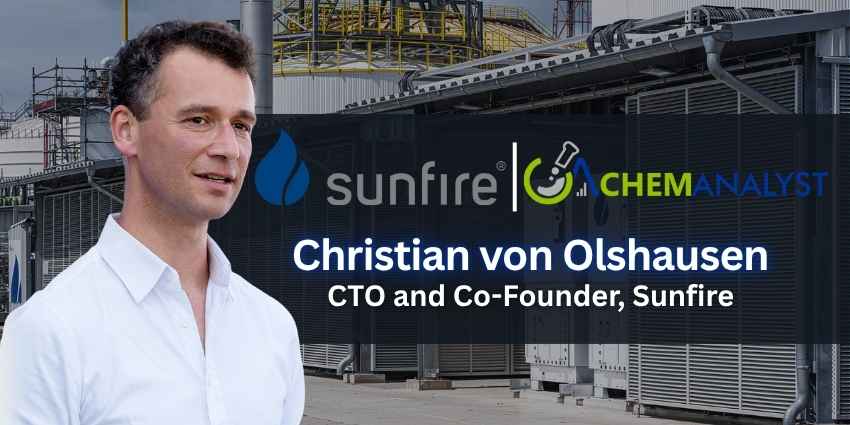Welcome To ChemAnalyst

The German company’s Solid Oxide Electrolysis Cell (SOEC) technology is deployed at Neste’s Rotterdam, Netherlands’ facility.
Europe’s push toward large-scale green hydrogen production has reached a major milestone with the successful commissioning of the MultiPLHY project — the world’s first high-temperature, multi-megawatt electrolyzer system integrated into an industrial operation. Launched in early 2020, the initiative unites leading industry partners Neste, Sunfire, CEA, Paul Wurth, and ENGIE, aiming to demonstrate how high-efficiency hydrogen production can be achieved within existing industrial settings.
The project is hosted at Neste’s renewable products refinery in Rotterdam, the Netherlands, one of the most advanced facilities globally for producing renewable diesel and sustainable aviation fuel (SAF). By coupling Sunfire’s Solid Oxide Electrolysis Cell (SOEC) technology with the refinery’s processes, MultiPLHY showcases how renewable electricity and waste heat can be leveraged to produce green hydrogen with exceptional efficiency.
In the following interview, Sunfire’s CTO and Co-Founder Christian von Olshausen sheds light on how its SOEC technology works, what makes it a game-changer for industrial-scale hydrogen production, and how the lessons from MultiPLHY are shaping the next generation of electrolyzers.
1. Can you explain how the SOEC (Solid Oxide Electrolysis Cell) technology works and what makes it suitable for industrial-scale hydrogen production? How are your electrolyzers different from traditional electrolyzers?
Solid Oxide Electrolysis Cell (SOEC) technology is an advanced form of electrolysis that operates at high temperatures around 850°C. At these elevated temperatures, water (steam) is split into hydrogen and oxygen using electricity and heat. Because much of the energy required for splitting water comes from heat rather than electricity, our SOEC technology achieves a significantly higher electrical efficiency compared to low-temperature electrolysis technologies.
The heart of an SOEC is a solid ceramic layer that lets oxygen ions pass through. Inside the cell, steam is turned into hydrogen at one side (the cathode). The oxygen moves through the ceramic and leaves as oxygen gas on the other side (the anode). This is the reverse of how a solid oxide fuel cell works.
So, what makes SOEC especially suitable for industrial-scale hydrogen production is its ability to integrate with existing industrial processes and use waste heat to further boost efficiency. The high operating temperature also enables co-electrolysis, where water and CO2 can be converted into syngas – a valuable feedstock for producing e-Fuels and chemicals.
SOEC combines superior efficiency, scalability, and process integration potential, making it a leading technology for decarbonizing hard-to-abate sectors and enabling large-scale green hydrogen and e-Fuel production.
2. This electrolyzer has been described as the world’s largest multi-megawatt high-temperature electrolyzer in an industrial setting . What does this mean for the broader hydrogen industry?
The MultiPLHY project marks a major milestone for the hydrogen industry. This commissioning proves that our SOEC technology can deliver on an industrial scale, following several successful demonstration projects at smaller capacities. The system shows that electrolysis can deliver the volumes of green hydrogen industry needs. What’s now required are the right political frameworks and final investment decisions to accelerate adoption and ensure that Europe secures technology leadership in the global hydrogen market.
3. Are there plans to further increase the capacity of this high-temperature electrolyzer? What’s next for Sunfire after this milestone — are there ongoing projects that build upon the learnings from MultiPLHY?
Within the ongoing test program of the MultiPLHY project, we are gathering valuable operational experience and performance data from the world’s largest SOEC electrolyzer in an industrial environment – insights that enable us to continuously further develop and optimize the technology. Building on these learnings, we’re upscaling SOEC for even larger applications, demonstrating that the technology is ready to deliver at multi-megawatt scale.
With the launch of our Generation 3 SOEC electrolysis technology last year, we are introducing a modular concept built around a powerful 10 MW module – designed for large-scale deployment, similar to our proven pressurized alkaline systems. We are ready to work with our customers to bring SOEC technology into applications in the double-digit, and soon even triple-digit, megawatt range – step by step, following the successful path we have already taken with our pressurized alkaline technology.
4. Do you see this project as a blueprint for future large-scale installations in other refineries or industrial clusters?
Absolutely. The MultiPLHY project demonstrates how SOEC technology can be deployed at industrial scale. Its modular, high-capacity design shows that these systems can be adapted to other refineries and industrial use cases, step by step, just as we have successfully scaled our pressurized alkaline technology. The project provides valuable operational data and insights that can be applied to near future installations, making it a blueprint for rolling out large-scale green hydrogen production across Europe and beyond.
We use cookies to deliver the best possible experience on our website. To learn more, visit our Privacy Policy. By continuing to use this site or by closing this box, you consent to our use of cookies. More info.
